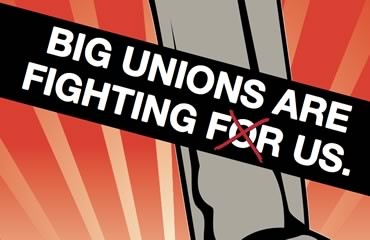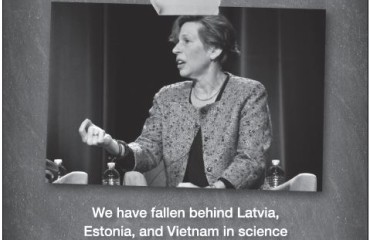 We’ve suspected that “worker centers” leading the walkouts of fast food restaurants and big-box retailers are union front groups, and evidence continues to pour in that not only are unions bankrolling the campaign, but unions are also deeply involved in strategy, organizing, and tactics. Two new items of evidence have come out in the past few weeks that show the Service Employees International Union (SEIU) is the force behind fast food worker walkouts and that these protests are anything but grassroots.
We’ve suspected that “worker centers” leading the walkouts of fast food restaurants and big-box retailers are union front groups, and evidence continues to pour in that not only are unions bankrolling the campaign, but unions are also deeply involved in strategy, organizing, and tactics. Two new items of evidence have come out in the past few weeks that show the Service Employees International Union (SEIU) is the force behind fast food worker walkouts and that these protests are anything but grassroots.
First are legal filings that the “Workers Committees” that are the embryonic labor unions supposedly leading the protests made with the Department of Labor. (Perhaps the possibility that the groups would be reclassified by courts as “labor organizations” spooked organizers into voluntary compliance with the law.) On the Forms LM-1 that unions are required to file with DoL when they are established, the new labor organizations must list their interim leadership. Five of these proto-unions’ Forms LM-1 are linked below, along with their presidents’ job titles as reported on various SEIU Forms LM-2 for 2012.
- Fast Food Workers Committee (New York): Kendall Fells, SEIU City Coordinator
- Workers Organizing Committee of Chicago: E.J. Serrano, SEIU Healthcare Illinois-Indiana Vice President
- Michigan Workers Organizing Committee: Mark Raleigh, SEIU Healthcare Michigan Chief of Staff
- St. Louis Organizing Committee: Grant Williams, SEIU City Coordinator
- Milwaukee Workers Organizing Committee: Michael Lauer, SEIU City Coordinator
That’s a lot of SEIU flacks who all just so happen to be the Presidents of these new “Workers Committees.” An article in the left-wing and generally very pro-union magazine In These Times explains why: The “Fight for 15” and Fast Food Forward (FFF) are basically all the SEIU’s idea, and the SEIU or its flacks make basically all of the decisions. For a supposedly “grassroots” campaign, SEIU has a big stake in FFF’s outcome and tactics:
But three former organizers in Chicago who joined the campaign in late 2011, and two former organizers with NYCC who began petitioning in March 2012, all dispute this story. All say that from the get-go, the stated goal was to organize low-wage or fast-food workers. All say they were told within weeks or months that SEIU was funding the organizing, and all say that it became increasingly clear that SEIU was directing the campaign.
Apparently organizers are even becoming disgruntled with SEIU’s top-down heavy-handed stage management of the walkouts:
Brooke (not his real name), who was hired by Action Now [an SEIU-backed worker center in Chicago] in December 2011, says that despite close supervision, organizing leaders denied they were in charge: “I was told, ‘It’s all about the workers. We have to leave it up to the workers.’ Then [SEIU leadership] tells the media, ‘It’s spontaneous; the workers came to us.’ It’s duplicitous. It’s to get people to stop asking questions.”
The stories from inside FFF and the other worker centers make these allegedly “grassroots” walkouts look highly coordinated and Astroturfed. The In These Times writer goes on:
In contrast, all three Chicago organizers say that by February, SEIU personnel were coming to their offices specifically to train them in union organizing. In other words, while SEIU maintains that Fight for 15 is a bottom-up project, the organizers who did the legwork concluded that SEIU funded and directed it from early on. […]
Carlos believes that “[SEIU’s] name has a lot of baggage, so they don’t want it out there. They want to funnel it through smaller organizations so it looks like more of a grassroots effort.”
And while the SEIU and its fronts claim widespread, national worker uprisings, outside of core, highly organized and stage-managed cities the campaign is petering. The story continues:
Outside of Chicago, however, there’s little evidence of worker-to-worker organizing. In Seattle and Washington, D.C., sources say active workers number a dozen or less, about the same as the number of paid organizers.
Meanwhile, the author’s sources suggest SEIU’s end-game involves a three-stage strategy that will end in unionization of the fast food industry. First, SEIU hopes to use the national “momentum” from the protests it is stage-managing to contest the legal distinction between brands and franchisees. (Typical fast food restaurants are owned and operated by small businesses independent of the national companies that provide supplies and rent their brand names.) Second, the SEIU will conduct “research” claiming widespread violation of labor laws to get the courts to rule in its favor (or the Administration to do it a favor). Finally, the SEIU will pressure the now-unified industry to agree to card-check unionization, stripping workers of their right to vote in private on whether to join SEIU.
It’s an audacious plan, but SEIU has staked millions on the battle. SEIU’s identified front groups received over $7 million in 2012 alone, and the In These Times report notes that one of SEIU’s main political consulting firms, BerlinRosen, has seen its retainer triple from 2010 to 2012. If employee rights stand in the way of SEIU’s millions, then expect SEIU to use every trick in the book to shove them aside.



